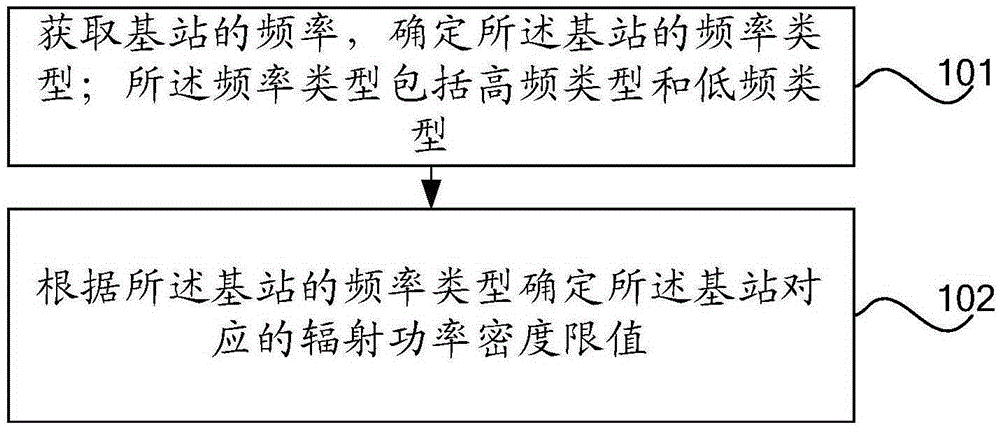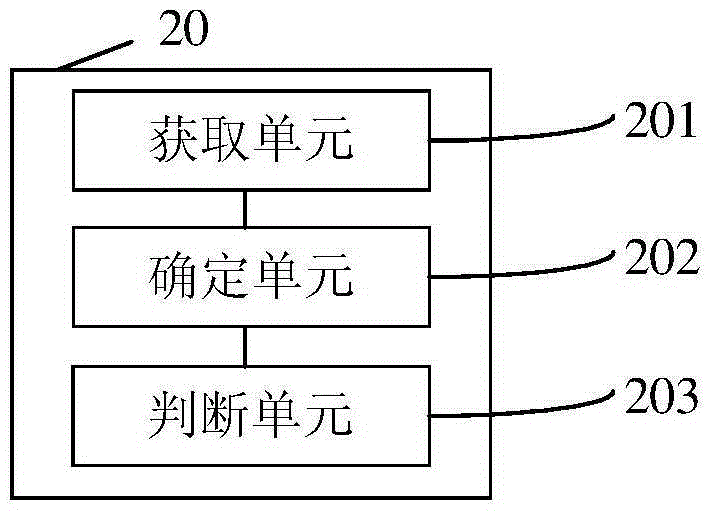Method and device for judging whether electromagnetic radiation of base station exceeds standard
A technology of electromagnetic radiation and base stations, applied in the field of communication, can solve the investment problems of the country and all operators
- Summary
- Abstract
- Description
- Claims
- Application Information
AI Technical Summary
Problems solved by technology
Method used
Image
Examples
Embodiment 1
[0035] An embodiment of the present invention provides a method for judging whether the electromagnetic radiation of a base station exceeds the standard, such as figure 1 As shown, the method includes the following steps:
[0036] 101. Acquire a frequency of a base station, and determine a frequency type of the base station; the frequency type includes a high-frequency type and a low-frequency type.
[0037] Wherein, the frequency is a transmission frequency of the base station, and the preset frequency threshold may be 2000 MHz. In addition, the frequency of the base station is less than or equal to 3000MHz.
[0038] In a specific implementation, if the frequency of the base station is greater than a preset frequency threshold, it is determined that the type of the base station is a high-frequency type; if the frequency of the base station is less than or equal to the preset frequency threshold, then the type of the base station is determined for the low frequency type.
...
Embodiment 2
[0051] An embodiment of the present invention provides a device 20, such as figure 2 As shown, the device 20 includes: an acquiring unit 201 , a determining unit 202 , and a judging unit 203 .
[0052] The obtaining unit 201 is configured to obtain the frequency of the base station.
[0053] The determining unit 202 is configured to determine a frequency type of the base station according to the frequency of the base station acquired by the acquiring unit 201; the frequency type includes a high frequency type and a low frequency type.
[0054] The determining unit 202 is further configured to determine the corresponding radiation power density limit of the base station according to the frequency type of the base station.
[0055] Since the effects of low-frequency electromagnetic radiation and high-frequency electromagnetic radiation are significantly different, if the radiation power density limit of base stations with a transmission frequency of 30-3000MHz is also stipulat...
Embodiment 3
[0066] An embodiment of the present invention provides a device 30, such as image 3 As shown, the device 30 includes: a processor 301 and a memory 302 .
[0067] Wherein, the processor 301 may be a central processing unit (English: central processing unit, abbreviation: CPU).
[0068] The memory 302 is used to store program codes, and transmit the program codes to the processor 301, and the processor 301 executes the following instructions according to the program codes. The memory 302 may include a volatile memory (English: volatile memory), such as a random access memory (English: random-access memory, abbreviated: RAM); the memory 302 may also include a non-volatile memory (English: non-volatile memory), such as Read-only memory (English: read-only memory, abbreviation: ROM), flash memory (English: flashmemory), hard disk (English: harddiskdrive, abbreviation: HDD) or solid-state drive (English: solid-state drive, abbreviation: SSD). The memory 302 may also include a com...
PUM
 Login to View More
Login to View More Abstract
Description
Claims
Application Information
 Login to View More
Login to View More - R&D
- Intellectual Property
- Life Sciences
- Materials
- Tech Scout
- Unparalleled Data Quality
- Higher Quality Content
- 60% Fewer Hallucinations
Browse by: Latest US Patents, China's latest patents, Technical Efficacy Thesaurus, Application Domain, Technology Topic, Popular Technical Reports.
© 2025 PatSnap. All rights reserved.Legal|Privacy policy|Modern Slavery Act Transparency Statement|Sitemap|About US| Contact US: help@patsnap.com



